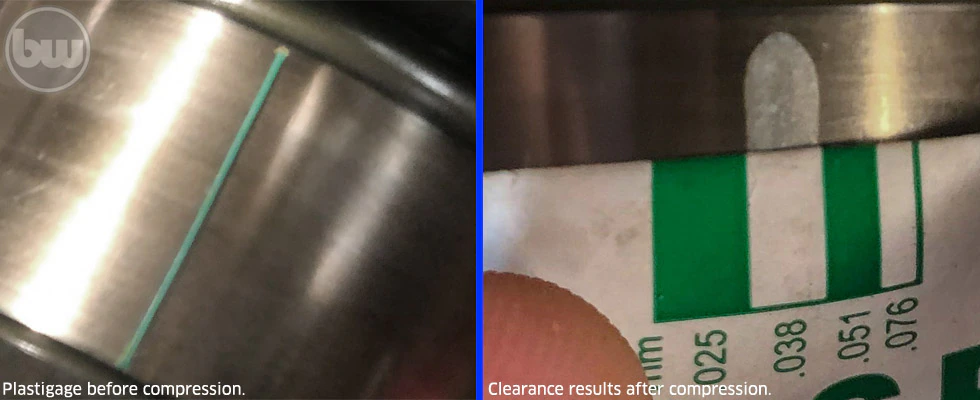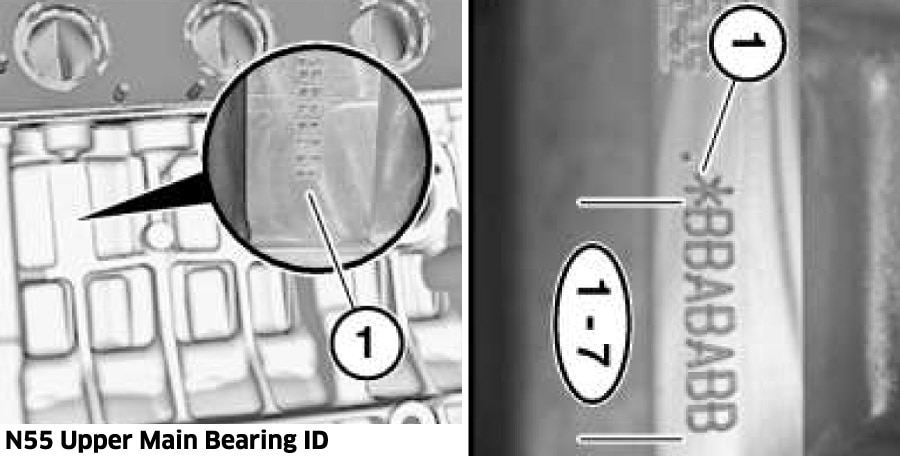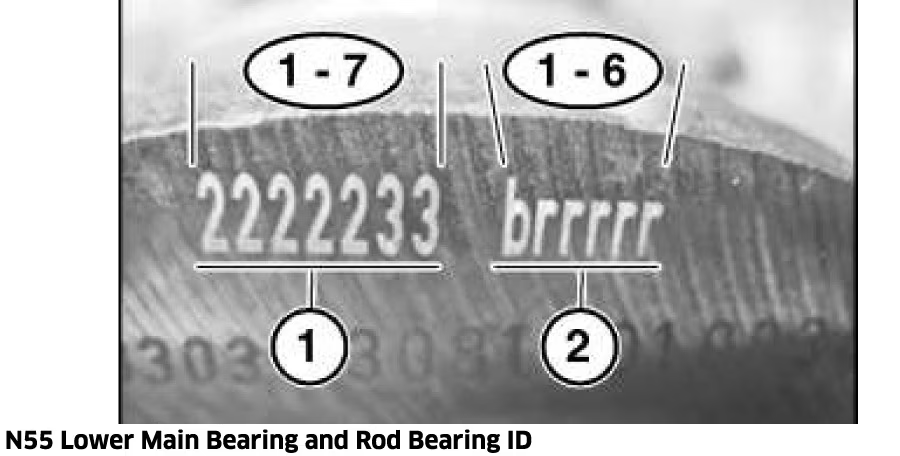|
BMW Rod and Main Engine Bearings
This page is a work-in-progress and should not be taken as gospel or the final word in engine bearing selection, measuring, or ordering.
The BMW engine crankshaft and connecting rods ride on thin metal rings called bearing shells. Over time these shells wear out and require replacement as any other normal wear item. In a perfect world the bearings wear out instead of the crankshaft. And when the bearings are fully worn you can simply replace them with fresh bearings.
BMW has never publicly stated a replacement interval or expected lifespan for any bearing shells. We've seen worn bearings from less than 50,000 miles and some that look good even at 200,000 miles. What could be "premature" may actually be normal wear or something else entirely. The only sure way to check bearing wear is by removing a bearing and inspecting it. This is not as involved or technically challenging as it sounds, especially if you already have the oil pan removed. A used oil analysis may give you early warning signs of bearing wear but is not as definitive as a physical check. Rod bearings can be replaced independent of main bearings but not vice versa.
STOP & READ: Engine building requires precision, patience, and awareness of when something is not correct. Mistakes and damage occurs from missing one, or more, of these key attributes. You don't have to be a master technician but you do have to know your limitations and be able to seek a local experienced machine shop or builder.
Bearing sizes are determined from two factors: Inside Diameter where the bearing grasps the crankshaft and Outside Diameter where the bearing sits in the connecting rod or engine block. The ID is going to be a fixed number to maintain a specific gap around the crankshaft for oil to occupy. The OD will vary by cylinder to account for slight differences in the casting, machining, or wear of the block, crankshaft, or connecting rod. This measurement is color coded. When looking at bearing part numbers in ETK/RealOEM there will usually be multiple bearing part numbers for each size and then separated by color. The color code is the bearing shell originally used in the engine assembly and it won't be unusual to have a mix of one or two different colors. The crankshaft will have a paint mark or code indicating which was used. See below for more info on BMW bearing shell colors.
If a crankshaft is damaged from a worn-out or dislodged (spun) bearing it will likely need machining to be usable again. Machining the crankshaft reduces the OD of the shaft, requiring bearing shells with a smaller ID. BMW makes undersized bearings for this purpose. Machining is typically done via "stages" so that bearings can be manufactured to pre-determined specs and expensive custom-sized bearings are not needed. The bearing ID becomes undersized but BMW will usually express that as "+0.25mm" as the bearings have more material to make up the difference. It's still an undersized bearing even though it's expressed as a larger size.
For example, an original spec may be 56.00mm. First machined bearings will be 55.75mm (.25mm removed from the crank). Second sized bearings will be 55.50mm (.50mm removed from crank). BMW typically does not produce bearings beyond a 2nd undersize.
Measuring for Bearings
M and S Engines up to 2006
There is always a standard bearing spec for each engine. However the best approach is to confirm the size to ensure the proper clearance is set. BMW recommends Plastigage as do many engine builders. Using ultra-precise micrometer measuring tools is no longer considered a requirement. This makes it easier for a DIY engine rebuild.
Plastigage is a thin putty-like material that will compress as the bearing and cap are tightened over it. The width of the compressed material represents your clearance. As long as the clearance is within spec your bearing is good. If the clearance is too large or too small a different bearing is required. You will need to check each connecting rod and main journal clearance with the Plastigage. BMW does not publish the clearance specs publicly but your BMW dealer can look them up.
For the M and S engine rebuilds, BMW recommends starting with the Yellow-coded bearing part numbers. OEM or aftermarket bearing sets are sold as the Yellow spec as well to make it easier. Use the Plastigage to determine bearing clearance. If each is within spec continue with the Yellow-coded bearings. If any cylinders are out of spec, switch to another color that will produce the correct spec. It would not be wrong to have a mix of colors on the same crankshaft and that's why BMW produces them in different colors. White is the thickest bearing and Yellow is the thinnest so if your gap is too large with the Yellow bearings you can use another color to fill in the gap until it's within spec. Remember, BMW does not publish the clearance specs publicly but your BMW dealer can look them up. 
N and S Engines from 2006
Starting with the N-series engines in 2006, BMW laser etches the rod bearing and main bearing codes onto components so mechanics can know what was originally equipped. The combination of these alpha-numeric codes corresponds to a matrix to indicate which bearing to use.
When replacing bearings you can refer to these codes and order replacement bearings but BMW still recommends checking bearing clearance using Plastigage and then switching to a different color if needed.
Plastigage is a thin putty-like material that will compress as the bearing and cap are tightened over it. The width of the compressed material represents your clearance (see image above). As long as the clearance is within spec your bearing is good. If the clearance is too large or too small a different bearing is required. You will need to check each connecting rod and main journal clearance with the Plastigage. BMW does not publish the clearance specs publicly but your BMW dealer can look them up.
Upper main bearing shells are etched with a alphabetic code on the side of the engine block. 
Lower main bearing shells are etched with a numeric code onto the first counterweight of the crankshaft.
Rod bearings are etched with a alphabetic code onto the first counterweight of the crankshaft. 
Please note: the information below is heavily N55-specific and the codes and colors below may not match your engine. BMW was not consistent on which codes correspond to specific colors.
Upper Main Bearing Codes (not N63/S63):
Code string is located vertically on a flat surface on the passenger side of the engine block. An asterisk "*" symbol or the letter "K" denotes the transmission end of the code string (see note below). In a typical BMW engine there is a main bearing for each cylinder plus one more for the thrust or guide bearing. The thrust bearing is typically in the middle. The upper bearings are designed with an oil lubricating groove. The code is alphabetical - A-F.
A = yellow code
B = green code
C = red code
D = blue code
E = brown code
F = purple code
NOTE: BMW N55 tech documents state: "[Upper] bearing seat assignment from 1 to 7, the first bearing position is indicated by an asterisk on the transmission side." We think "transmission" is a misprint and it should be "timing side" like the lower and rod bearings are labeled. But we don't have confirmation on this. If it is transmission side then the order is reversed compared to the lower bearings! Regardless, the layout should make sense if you take a picture with your phone, then turn the image 90° counter-clockwise.
Update: other BMW documents are more logical: "the seventh bearing position is located on the clutch side and is indicated by an asterisk". But we still have not seen a correction to the N55 text.
Lower Main Bearing Codes (not N63/S63):
Code string is located on the first/front counterweight of the crankshaft. The lower bearings have a smooth surface with no oil groove.
1 = yellow
2 = green
3 = red
4 = blue
5 = brown
6 = purple
Main bearing code example: BBCBCBB on the block and 1222211 on the crank. In this case your cylinders are laid out with these combinations:
Cyl 1 = green/yellow
Cyl 2 = green/green
Cyl 3 = red/green
Thrust = green/green
Cyl 4 = red/green
Cyl 5 = green/yellow
Cyl 6 = green/yellow
Note: yellow and red are never used together. BMW calls for a green/green combination in this case.
N63/S63 Main Bearing Codes
The main and thrust bearings are a confusing and convoluted process that probably requires direct consultation with your dealer. There are five main bearings with #3 being a thrust/guide bearing which is a different design but follows the same color and code logic. The crankcase code is on the outside of the passenger engine block. The lower code is on the first counterweight of the crankshaft. There are three color codes: yellow, green, violet. But for some reason BMW used multiple letters for each color.
A-H codes are the yellow bearing code.
I-R codes are the green bearing code.
S-Z codes are the violet bearing code.
There is a more extensive matrix table that BMW can provide if you want the official confirmation on what to order.
Rod Bearing Codes:
Code string is located on the first/front counterweight of the crankshaft. The code is alphabetical with one letter being for a upper and lower bearing shell combination. Rod bearings have 4 colors that are split into two color combinations:
b = blue combination consists of a violet/purple upper shell and a blue lower shell
r = red combination consists of a yellow upper shell and red lower shell
Note: colors are never mixed beyond these two combinations.
Rod bearing code example: bbrbrr. In this case your cylinders are laid out with this combination:
Cyl 1 = violet/blue
Cyl 2 = violet/blue
Cyl 3 = yellow/red
Cyl 4 = violet/blue
Cyl 5 = yellow/red
Cyl 6 = yellow/red
When new bearings are being fitted BMW recommends checking clearance with Plastigage to ensure proper clearance. You can use the pre-assigned color codes as a starting point and then change colors based on the results of your Plastigage checks.
Bearings with More Clearance
Since 2013 or so it's been common to replace the factory bearings on some engines with undersized bearings to increase the clearance. After consulting with well-established BMW engine builders the feeling in the BMW community was that the factory oil clearance was too tight, less than 0.02mm on some engines and that factory oil viscosity was too thick. This led to insufficient oil coverage on cold starts and “premature” bearing failure (there actually is no replacement interval for bearings so it can't be “premature”). We don't have an official recommendation and we support whichever path an informed customer chooses. We appreciate the arguments on both sides but prefer not to pick a winner. We offer both. It should also be said that not every engine-crank-rod-bearing will result in a “too tight” scenario. There is no single “best bearing” or “correct size” that works in every application. There is only one preferred final clearance as determined by you or your engine builder. Some say it's 0.032mm. Others will say 0.0254mm (0.001"). The general rule is: the tighter the bearing clearance, the more power it's going to make. The wider the clearance, the longer it's going to last.
There are other factors in play as well - warm-up routine, driving habits, and the many choices of oil. If you plan to run an oil with a thin-ish viscosity when cold the extra bearing clearance may not be necessary. Note: the “10W” in an oil viscosity is vague and misleading and you really need to pay attention to the published data. If you only insist on using factory 10W60 a wider clearance is probably your best bet. And don't overlook the importance of proper warm-up!
Oil Priming
Before you start the engine after a rebuild* you must prime the oil system first.
* - in our experience oil priming is required in more cases than an engine rebuild. Any time the crank or rod bearings are replaced, VANOS replacement, camshafts removed, cylinder head removed, oil filter housing and gasket removed, and obviously the oil pump. Any interruption of the oil circulation system requires re-distributing engine oil to key areas. It's vital to recirculate oil to all critical areas before the engine is fired and running. By then it's too late to get lubrication to critical areas. An engine assembly lube is not designed to protect surfaces with the engine running, like engine oil will do.
Priming the oil system requires disabling one or more fuel or ignition systems, rotating the engine assembly by hand, then cranking the engine using the starter motor for a specified amount of time. Then repeating the process after a cool-down period. The BMW-recommended procedure for oil priming varies depending on which engine repair/replacement was performed so check with your BMW dealer for the latest and most appropriate procedure.
| Sort by Name | Sort by Price |

